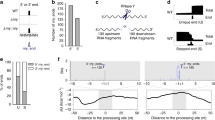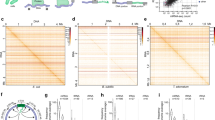Abstract
The first step in the post-transcriptional regulatory function of most bacterial small non-coding RNAs (sRNAs) is base pairing with partially complementary sequences of targeted transcripts. We present a simple method for identifying sRNA targets in vivo and defining processing sites of the regulated transcripts. The technique, referred to as global small non-coding RNA target identification by ligation and sequencing (GRIL-seq), is based on preferential ligation of sRNAs to the ends of base-paired targets in bacteria co-expressing T4 RNA ligase, followed by sequencing to identify the chimaeras. In addition to the RNA chaperone Hfq, the GRIL-seq method depends on the activity of the pyrophosphorylase RppH. Using PrrF1, an iron-regulated sRNA in Pseudomonas aeruginosa, we demonstrated that direct regulatory targets of this sRNA can readily be identified. Therefore, GRIL-seq represents a powerful tool not only for identifying direct targets of sRNAs in a variety of environments, but also for uncovering novel roles for sRNAs and their targets in complex regulatory networks.
This is a preview of subscription content, access via your institution
Access options
Subscribe to this journal
Receive 12 digital issues and online access to articles
$119.00 per year
only $9.92 per issue
Buy this article
- Purchase on Springer Link
- Instant access to full article PDF
Prices may be subject to local taxes which are calculated during checkout





Similar content being viewed by others
Change history
14 July 2017
In the PDF version of this article previously published, the year of publication provided in the footer of each page and in the 'How to cite' section was erroneously given as 2017, it should have been 2016. This error has now been corrected. The HTML version of the article was not affected.
References
Lenz, D. H. et al. The small RNA chaperone Hfq and multiple small RNAs control quorum sensing in Vibrio harveyi and Vibrio cholerae. Cell 118, 69–82 (2004).
Gottesman, S. Micros for microbes: non-coding regulatory RNAs in bacteria. Trends Genet. 21, 399–404 (2005).
Gottesman, S. & Storz, G. Bacterial small RNA regulators: versatile roles and rapidly evolving variations. Cold Spring Harb. Perspect. Biol. 3, a003798 (2011).
Caldelari, I., Chao, Y., Romby, P. & Vogel, J. RNA-mediated regulation in pathogenic bacteria. Cold Spring Harb. Perspect. Med. 3, a010298 (2013).
Papenfort, K. & Vogel, J. Small RNA functions in carbon metabolism and virulence of enteric pathogens. Front. Cell. Infect. Microbiol. 4, 91 (2014).
Oliva, G., Sahr, T. & Buchrieser, C. Small RNAs, 5′ UTR elements and RNA-binding proteins in intracellular bacteria: impact on metabolism and virulence. FEMS Microbiol. Rev. 39, 331–349 (2015).
Pain, A. et al. An assessment of bacterial small RNA target prediction programs. RNA Biol. 12, 509–513 (2015).
Vakulskas, C. A., Potts, A. H., Babitzke, P., Ahmer, B. M. & Romeo, T. Regulation of bacterial virulence by Csr (Rsm) systems. Microbiol. Mol. Biol. Rev. 79, 193–224 (2015).
Vogel, J. & Luisi, B. F. Hfq and its constellation of RNA. Nat. Rev. Microbiol. 9, 578–589 (2011).
Sharma, C. M. et al. Pervasive post-transcriptional control of genes involved in amino acid metabolism by the Hfq-dependent GcvB small RNA. Mol. Microbiol. 81, 1144–1165 (2011).
Frohlich, K. S. & Vogel, J. Activation of gene expression by small RNA. Curr. Opin. Microbiol. 12, 674–682 (2009).
Papenfort, K. & Vanderpool, C. K. Target activation by regulatory RNAs in bacteria. FEMS Microbiol. Rev. 39, 362–378 (2015).
Storz, G., Vogel, J. & Wassarman, K. M. Regulation by small RNAs in bacteria: expanding frontiers. Mol. Cell 43, 880–891 (2011).
Helwak, A. & Tollervey, D. Mapping the miRNA interactome by cross-linking ligation and sequencing of hybrids (CLASH). Nat. Protoc. 9, 711–728 (2014).
Grosswendt, S. et al. Unambiguous identification of miRNA:target site interactions by different types of ligation reactions. Mol. Cell 54, 1042–1054 (2014).
Masse, E., Vanderpool, C. K. & Gottesman, S. Effect of RyhB small RNA on global iron use in Escherichia coli. J. Bacteriol. 187, 6962–6971 (2005).
Papenfort, K. et al. σE-dependent small RNAs of Salmonella respond to membrane stress by accelerating global omp mRNA decay. Mol. Microbiol. 62, 1674–1688 (2006).
Zhang, A. et al. Global analysis of small RNA and mRNA targets of Hfq. Mol. Microbiol. 50, 1111–1124 (2003).
Sittka, A. et al. Deep sequencing analysis of small noncoding RNA and mRNA targets of the global post-transcriptional regulator, Hfq. PLoS Genet. 4, e1000163 (2008).
Lalaouna, D. et al. A 3′ external transcribed spacer in a tRNA transcript acts as a sponge for small RNAs to prevent transcriptional noise. Mol. Cell 58, 393–405 (2015).
Bandyra, K. J. et al. The seed region of a small RNA drives the controlled destruction of the target mRNA by the endoribonuclease RNase E. Mol. Cell 47, 943–953 (2012).
Wilderman, P. J. et al. Identification of tandem duplicate regulatory small RNAs in Pseudomonas aeruginosa involved in iron homeostasis. Proc. Natl Acad. Sci. USA 101, 9792–9797 (2004).
Masse, E. & Gottesman, S. A small RNA regulates the expression of genes involved in iron metabolism in Escherichia coli. Proc. Natl Acad. Sci. USA 99, 4620–4625 (2002).
Oglesby, A. G. et al. The influence of iron on Pseudomonas aeruginosa physiology: a regulatory link between iron and quorum sensing. J. Biol. Chem. 283, 15558–15567 (2008).
Hui, M. P., Foley, P. L. & Belasco, J. G. Messenger RNA degradation in bacterial cells. Annu. Rev. Genet. 48, 537–559 (2014).
Pfeiffer, V., Papenfort, K., Lucchini, S., Hinton, J. C. & Vogel, J. Coding sequence targeting by MicC RNA reveals bacterial mRNA silencing downstream of translational initiation. Nat. Struct. Mol. Biol. 16, 840–846 (2009).
Heaphy, S., Singh, M. & Gait, M. J. Effect of single amino acid changes in the region of the adenylylation site of T4 RNA ligase. Biochemistry 26, 1688–1696 (1987).
Deana, A., Celesnik, H. & Belasco, J. G. The bacterial enzyme RppH triggers messenger RNA degradation by 5' pyrophosphate removal. Nature 451, 355–358 (2008).
Wright, P. R. et al. CopraRNA and IntaRNA: predicting small RNA targets, networks and interaction domains. Nucleic Acids Res. 42, W119–W123 (2014).
Busch, A., Richter, A. S. & Backofen, R. IntaRNA: efficient prediction of bacterial sRNA targets incorporating target site accessibility and seed regions. Bioinformatics 24, 2849–2856 (2008).
Sonnleitner, E., Abdou, L. & Haas, D. Small RNA as global regulator of carbon catabolite repression in Pseudomonas aeruginosa. Proc. Natl Acad. Sci. USA 106, 21866–21871 (2009).
Sonnleitner, E. & Blasi, U. Regulation of Hfq by the RNA CrcZ in Pseudomonas aeruginosa carbon catabolite repression. PLoS Genet. 10, e1004440 (2014).
Rasmussen, A. A. et al. A conserved small RNA promotes silencing of the outer membrane protein YbfM. Mol. Microbiol. 72, 566–577 (2009).
Tree, J. J., Granneman, S., McAteer, S. P., Tollervey, D. & Gally, D. L. Identification of bacteriophage-encoded anti-sRNAs in pathogenic Escherichia coli. Mol. Cell 55, 199–213 (2014).
Azam, M. S. & Vanderpool, C. K. Talk among yourselves: RNA sponges mediate cross talk between functionally related messenger RNAs. EMBO J. 34, 1436–1438 (2015).
Wurtzel, O. et al. The single-nucleotide resolution transcriptome of Pseudomonas aeruginosa grown in body temperature. PLoS Path. 8, e1002945 (2012).
Lee, T. & Feig, A. L. The RNA binding protein Hfq interacts specifically with tRNAs. RNA 14, 514–523 (2008).
Morita, T., Mochizuki, Y. & Aiba, H. Translational repression is sufficient for gene silencing by bacterial small noncoding RNAs in the absence of mRNA destruction. Proc. Natl Acad. Sci. USA 103, 4858–4863 (2006).
Mustachio, L. M. et al. The Vibrio cholerae mannitol transporter is regulated posttranscriptionally by the MtlS small regulatory RNA. J. Bacteriol. 194, 598–606 (2012).
Melamed, S. et al. Global mapping of small RNA–target interactions in bacteria. Mol. Cell 63, 884–897 (2016).
Attaiech, L. et al. Silencing of natural transformation by an RNA chaperone and a multitarget small RNA. Proc. Natl Acad. Sci. USA 113, 8813–8818 (2016).
Rietsch, A., Vallet-Gely, I., Dove, S. L. & Mekalanos, J. J. Exse, a secreted regulator of type III secretion genes in Pseudomonas aeruginosa. Proc. Natl Acad. Sci. USA 102, 8006–8011 (2005).
Tjaden, B. et al. Target prediction for small, noncoding RNAs in bacteria. Nucleic Acids Res. 34, 2791–2802 (2006).
Prevost, K. et al. The small RNA RyhB activates the translation of shiA mRNA encoding a permease of shikimate, a compound involved in siderophore synthesis. Mol. Microbiol. 64, 1260–1273 (2007).
Morrissey, D. V. et al. Nucleic acid hybridization assays employing dA-tailed capture probes. I. Multiple capture methods. Anal. Biochem. 181, 345–359 (1989).
McClure, R. et al. Computational analysis of bacterial RNA-seq data. Nucleic Acids Res. 41, e140 (2013).
Bullard, J. H., Purdom, E., Hansen, K. D. & Dudoit, S. Evaluation of statistical methods for normalization and differential expression in mRNA-seq experiments. BMC Bioinformatics 11, 94 (2010).
Love, M. I., Huber, W. & Anders, S. Moderated estimation of fold change and dispersion for RNA-seq data with DESeq2. Genome Biol. 15, 550 (2014).
Benjamini, Y. & Hochberg, Y. Controlling the false discovery rate: a practical and powerful approach to multiple testing. J. R. Stat. Soc. Series B Stat. Methodol. 57, 289–300 (1995).
Acknowledgements
We thank U. Das and S. Shuman for the gift of a recombinant plasmid with the T4 RNA ligase gene and W. Robins for help with Illumina sequencing. We thank T. Dougherty for critical reading of the manuscript. This work was supported by National Institutes of Health grant R37 AI021451 to S.L. and R15 GM102755 to B.T.
Author information
Authors and Affiliations
Contributions
S.L. and K.H. conceived the approach. K.H. carried out all of the experiments. S.L., K.H. and B.T. analysed the expression and GRIL-seq data. S.L., K.H. and B.T. wrote the paper.
Corresponding author
Ethics declarations
Competing interests
The authors declare no competing financial interests.
Supplementary information
Supplementary Information
Supplementary Notes 1-5, Supplementary Methods, Supplementary Figures 1–15, Supplementary Tables 3–5, Supplementary References. (PDF 9943 kb)
Supplementary Tables 1 and 2
Supplementary Table 1: RNA-seq analysis, Supplementary Table 2: GRIL-seq analysis. (XLSX 800 kb)
Rights and permissions
About this article
Cite this article
Han, K., Tjaden, B. & Lory, S. GRIL-seq provides a method for identifying direct targets of bacterial small regulatory RNA by in vivo proximity ligation. Nat Microbiol 2, 16239 (2017). https://doi.org/10.1038/nmicrobiol.2016.239
Received:
Accepted:
Published:
DOI: https://doi.org/10.1038/nmicrobiol.2016.239
This article is cited by
-
TargetRNA3: predicting prokaryotic RNA regulatory targets with machine learning
Genome Biology (2023)
-
In vivo RNA interactome profiling reveals 3’UTR-processed small RNA targeting a central regulatory hub
Nature Communications (2023)
-
The core and accessory Hfq interactomes across Pseudomonas aeruginosa lineages
Nature Communications (2022)
-
High-throughput screen reveals sRNAs regulating crRNA biogenesis by targeting CRISPR leader to repress Rho termination
Nature Communications (2019)
-
Interplay and Targetome of the Two Conserved Cyanobacterial sRNAs Yfr1 and Yfr2 in Prochlorococcus MED4
Scientific Reports (2019)



